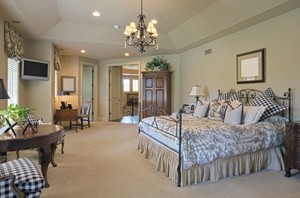
Looking backwards is always a curious way to move forwards in terms of interior decorating styles.
Past fashions are constantly being revitalised and reborn, introducing new elements to an old look to create an entirely unique modern piece. A currently popular method of decorating with the past is utilising themes from the 80s, however if you want to exude both style and originality, consider a theme from a little further back.
By bringing forth classic stylings from the Renaissance era, you can lavish your home in an ornate, high-class sensibility. Here are some tips to get started.
Starting from scratch
If you're building a new home, or performing extensive renovations, there are some architectural ideas you can design right from the word go.
For example, in past Italian culture, nobles and other gentry would build their homes with high ceilings to give them a sense of both space and grandeur. The lower class you were, the lower a ceiling you had. Though not for strict class purposes, you can still recreate the impression high ceilings gave these buildings by using them in your own home. Living rooms, dining rooms or any other public space feels great with a high ceiling, as there is plenty of room to breathe.
Another way to add some detail and intrigue to a space is to install an ornate and well-decorated ceiling. These were used frequently during many different Renaissance eras, and can be either extraordinarily lavish or simple in design, depending on your own taste. Ceiling medallions lining the joint between the wall and roof add texture to the area, as do something as simple as crisscrossed beams.
The colours
When you decide on the paint colours of your home, that's when you'll figure out how full-Renaissance you want to go. You can have this opulent theme in your home while still surrounding the area with modern colours, or you can indulge completely and investigate the brilliant oak and walnut looks of yesteryear.
For the latter, you will need to mix up both wooden textures and deep reds, though deep greens and blues don't go amiss, either. Consider floors of well-polished Resene Walnut, with Resene Colonial White for your walls. Both will stand out as they contrast with each other, coinciding nicely in the space and not detracting from one another. To add some more colour, use a paint like Resene Burnt Sienna to add a deep, classy red to feature areas, alongside patterned curtains such as Resene Designite – Merlot.
Alternatively, there's no need to entirely sacrifice a modern neutral look in order to achieve the stylings of the Renaissance era. For example, rather than highlighting a space with red, you could instead use a darker neutral such as Resene Stack to bring out a more traditional contemporary look.
Decoration and furniture
To make or break your Renaissance theme, you need to decorate properly. This is another time you can decide whether or not to commit fully to a classic look or blend it with a more modern approach.
Four-poster beds were common during this historic era, usually constructed with a strong, dark wood and carved with intricate patterns. Though many antique furniture stores or second hand shops will no doubt stock 20th Century variants of this design, there are plenty of modern evolutions to choose from as well from certain high-class furniture stores.
To add a third dimension to your high ceiling, add a sparkling chandelier above the dining room table. Not only will this provide lighting for your king-worthy banquets at night, it will also reflect and glow with the sunlight during the day.
Lastly, think soft materials and silks. Silk cushions and other furniture drapes were common during the Renaissance, though can come in a range of both classic and contemporary designs nowadays. Not to mention the fact that they feel great and are comfortable to sit on.


